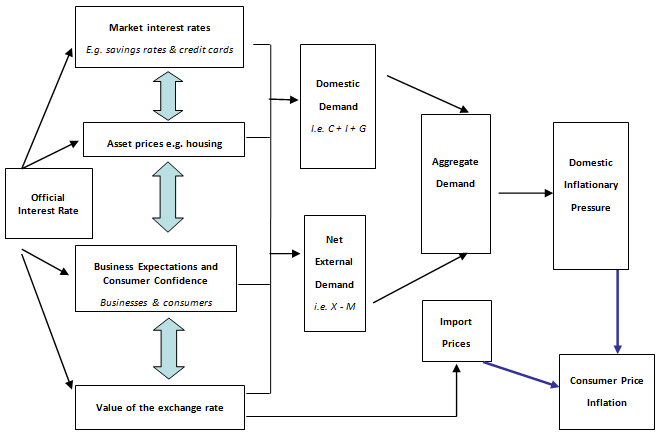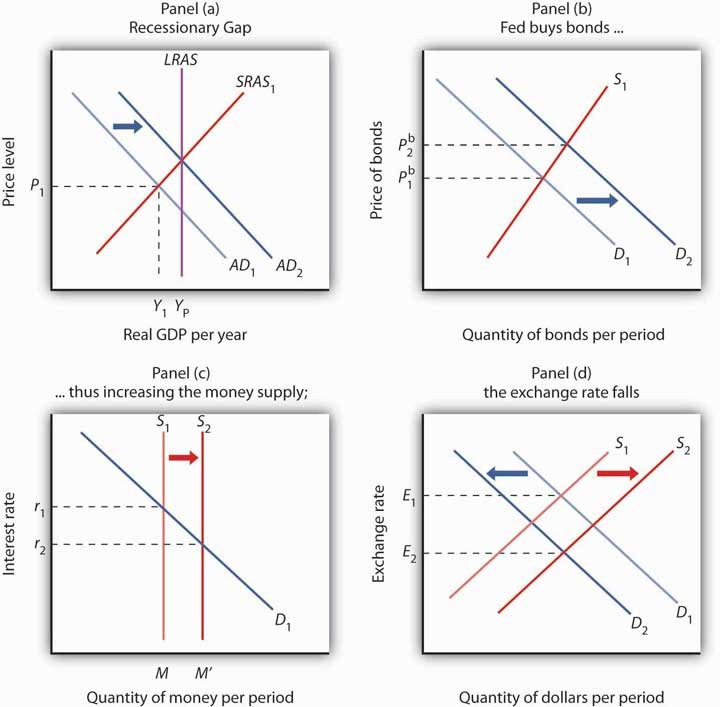Expansionary Monetary Policy Definition Purpose Tools
Post on: 3 Апрель, 2015 No Comment

How Today’s Low Interest Rates Create More Money for You
Expansionary monetary policy is like adding cash to the economy. Photo: Deborah Harrison/Getty Images
Definition: Expansionary monetary policy is when a central bank. such as the Federal Reserve. uses its tools to stimulate the economy. The effect is an increase in the money supply. l ower interest rates. and a rise in overall aggregate demand. This will boost growth as measured by Gross Domestic Product ( GDP ). It usually lowers the value of the currency, thereby de creasing the exchange rate. It is the opposite of contractionary monetary policy.
Expansionary monetary policy is used to ward off the contractionary phase of the business cycle. However, it is difficult for policymakers to always catch this in time. Therefore, you will most often see expansionary policy used after a recession has already started.
How Expansive Monetary Policy Works
The Fed’s most commonly used tool is open market operations. That’s when the it buys Treasury notes from its member banks. Where does it get the funds to do so? The Fed simply creates the credit out of thin air. This is what people mean when they say the Fed is printing money.
By replacing Treasury notes with credit in bank coffers, the Fed gives them more money to lend. Banks reduce lending rates, making loans for auto, school, and homes expensive. With cheaper credit card interest rates. boosting consumer spending.
Business loans are cheaper, so companies can expand to keep up with consumer demand. They ultimately hire more workers, whose incomes rise, allowing them to shop even more. This is usually enough to stimulate demand, and drive economic growth to a healthy 2-3% rate.
If not, then the FOMC lowers the Fed funds rate. This is the rate banks charge each other for overnight deposits. The Fed requires banks to keep a certain amount of their deposits in reserve at their local Federal Reserve branch office every night. Those banks that have more than they need will lend the excess to banks who don’t have enough, charging the Fed funds rate. When the Fed drops the target rate, it becomes cheaper for banks to maintain their reserves, giving them more money to lend. As a result, banks can lower the interest rates they charge their customers.
The third tool the Fed has is lowering the discount rate. That’s what it charges banks who borrow from its discount window. However, banks rarely use the discount window because there is a stigma attached. The Fed is considered to be a lender of last resort. Banks only use the discount window when they can’t get loans from any other banks. Banks hold this viewpoint, even though the discount rate is usually lower than the Fed funds rate. Nevertheless, the Fed usually drops the discount rate when it lowers the target for the Fed funds rate.
The Fed hardly ever uses its other tool, lowering the reserve requirement. Even though this immediately increase liquidity, it also requires a lot of new policies and procedures for member banks. It’s much easier to lower the Fed funds rate, and it’s just as effective. For more, see Monetary Policy Tools .
Expansionary vs Contractionary Monetary Policy
If the Fed puts too much liquidity into the banking system, it risks triggering inflation. That’s when prices rise more than the Fed’s 2% inflation target. The Fed sets this target to stimulate healthy demand. When consumers expect prices to increase gradually, they are more likely to buy more now.

The trouble starts when inflation gets higher than 2-3%. Consumers start stocking up to avoid higher prices later. This drives demand faster, which triggers businesses to produce more, and hire more workers. The additional income allows people to spend more, stimulating more demand. Sometimes businesses start raising prices because they know they can’t product enough. Other times, they raise prices because their costs are rising. If it spirals out of control, it can create hyperinflation. That’s when prices rise 50% or more — a month! For more, see Types of Inflation .
To stop inflation, the Fed puts on the brakes by implementing contractionary or restrictive monetary policy. The Fed raises interest rates, and sells its holdings of Treasuries and other bonds. This reduces the money supply, restricts liquidity and cools economic growth. The Fed’s goal is to keep inflation near its 2% target. while keeping unemployment low as well.
Innovative Tools That Conquered the Great Recession
Under the leadership of Federal Reserve Chairman Ben Bernanke. the Fed created an alphabet soup of innovative expansionary monetary policy tools to combat the 2008 financial crisis. They were all ways to pump more credit into the financial system. The TAF, or Term Auction Facility. allowed banks to sell their subprime mortgage-backed securities to the Fed. In conjunction with the Treasury Department. the Fed offered TALF, or Term Asset-Backed Securities Loan Facility. which did the same for financial institutions holding subprime credit card debt.
In response to a destructive run on money market funds on September 19, 2008, the Fed established the AMLF, or Asset Backed Commercial Paper Money Market Mutual Fund Liquidity Facility. This program loaned $122.8 billion to banks then lend to money market funds. In October, the Fed created the MMIFF, or Money Market Investor Funding Facility, which lent directly to the money markets themselves.
The good news is that the Fed reacted quickly and creatively to stave off financial collapse. The credit markets had frozen up, and without this decisive response the day-to-day cash that businesses use to keep running would have gone dry. The bad news is that the public did not understand what the programs did, so became suspicious of the Fed’s motives and power. This led to a drive to have the Fed audited. which was partially fulfilled by the Dodd-Frank Wall Street Reform Act.
The Fed also created a more powerful form of open market operations known as Quantitative Easing. where it added mortgage-backed securities to its purchases. In 2011, the Fed created Operation Twist. When its short-term notes came due, it sold them and used the proceeds to buy long-term Treasury notes. This lowered long-term interest rates, making mortgages more affordable. Article updated January 13, 2015.














